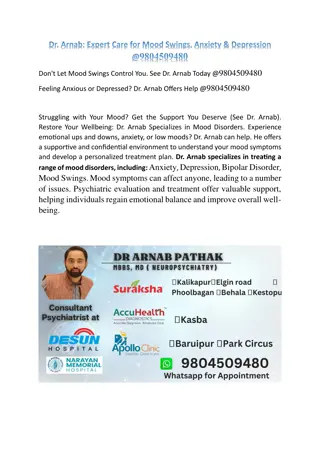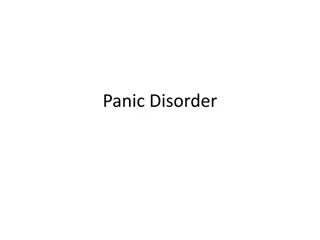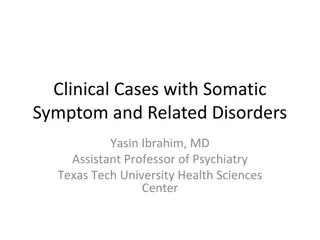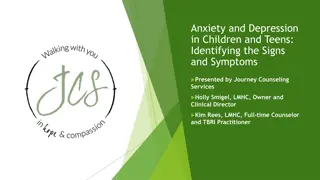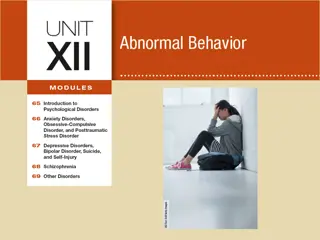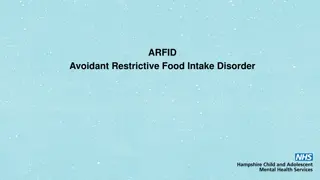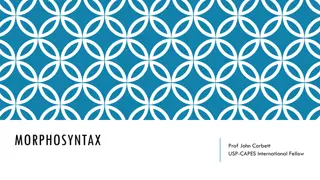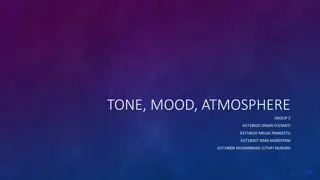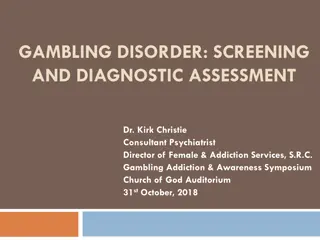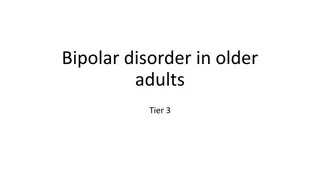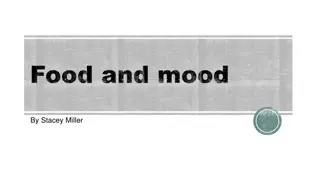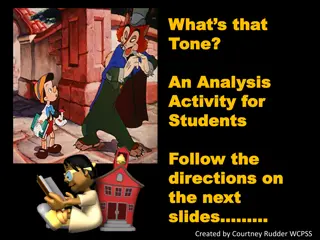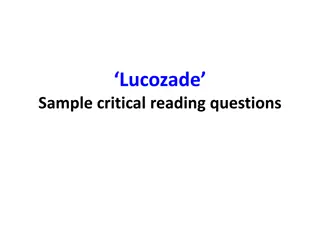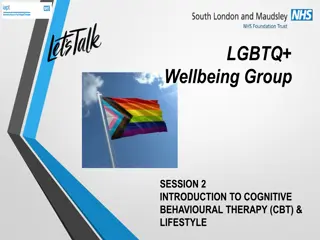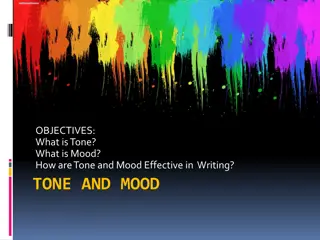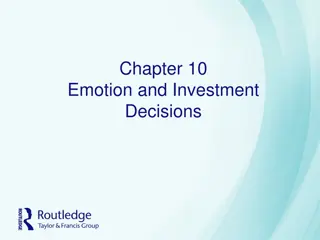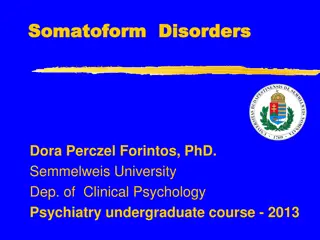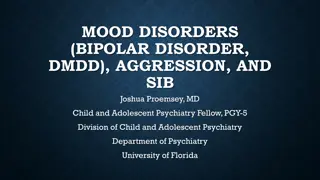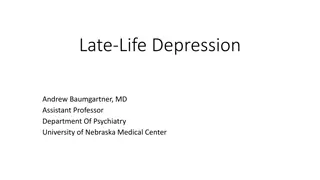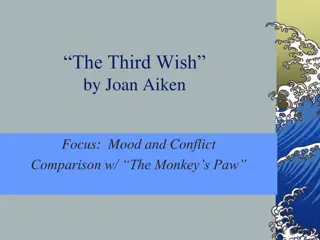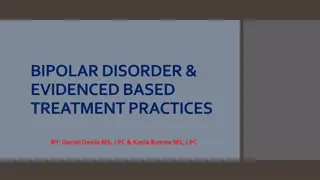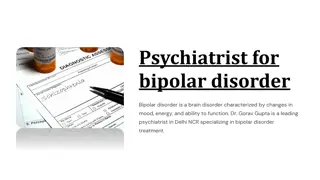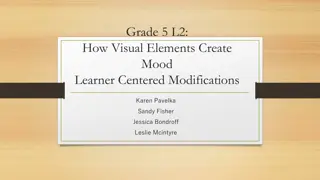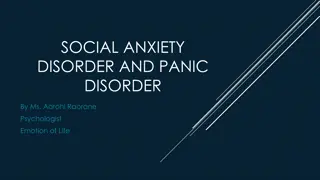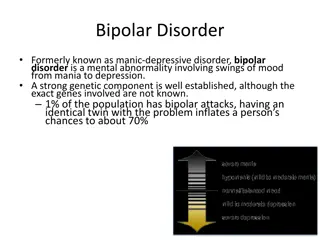Approach to Depression in Primary Care by Dr. Jon Davine
In this presentation, Dr. Jon Davine discusses the approach to depression in primary care, covering topics such as differential diagnosis, antidepressant medication selection, augmentation techniques, and treatment options like ECT and TMS. The sad state is explored through differential diagnoses, i
5 views • 56 slides
Feeling Down Dr. Arnab Can Help with Mood Issues @9804509480. Arnab Can Help with Mood Issues @9804509480
Struggling with Your Mood? Get the Support You Deserve (See Dr. Arnab). Restore Your Wellbeing: Dr. Arnab Specializes in Mood Disorders. Experience emotional ups and downs, anxiety, or low moods? Dr. Arnab can help. He offers a supportive and confidential environment to understand your mood symptoms
1 views • 2 slides
Understanding Panic Disorder: Symptoms, Diagnosis, and Management
Panic disorder is characterized by sudden, intense surges of fear or discomfort known as panic attacks. Individuals with this disorder may experience symptoms like chest pain, shortness of breath, dizziness, and a fear of having a heart attack. Differential diagnosis includes conditions like coronar
0 views • 8 slides
Understanding Anxiety Disorders and Related Conditions
Explore the distinguishing features of anxiety disorders such as generalized anxiety disorder, panic disorder, and phobias, along with insights into obsessive-compulsive disorder (OCD) and posttraumatic stress disorder (PTSD). Delve into the impact of conditioning, cognition, and biology on these co
2 views • 46 slides
Complex Case Study: Chronic Pain and Somatic Symptom Disorder
Michelle Adams, a 51-year-old hairdresser, presents with severe chronic back pain following a traumatic incident. Despite various treatments and medications, her pain persists, leading to distress and functional impairment. Her symptoms align with Somatic Symptom Disorder (SSD) with predominant pain
0 views • 50 slides
Understanding Anxiety and Depression in Children and Teens
This presentation by Journey Counseling Services delves into identifying signs and symptoms of anxiety and depression in children and teens. Topics include the different components of anxiety, common signs and symptoms, and various types of anxieties such as phobias, separation anxiety, generalized
1 views • 11 slides
Understanding Depressive Disorders and Bipolar Disorder
Depression is prevalent among students and individuals in the US. Major depressive disorder and persistent depressive disorder are characterized by varying degrees of depressive symptoms lasting for different durations. The diagnostic criteria include signs of depression persisting for specific peri
1 views • 57 slides
Understanding ARFID: A Guide to Avoidant Restrictive Food Intake Disorder
Avoidant Restrictive Food Intake Disorder (ARFID) is a feeding and eating disorder characterized by significant weight loss, nutritional deficiency, and psychosocial impairment. Individuals may experience sensory sensitivity, lack of interest, or fear of aversive consequences. ARFID differs from pic
0 views • 18 slides
Understanding Mood and Modality in Morphosyntax with Prof. John Corbett
Today's session with Prof. John Corbett explores the final three sets of grammatical categories related to verbs: mood (fact or non-fact), modality (speaker's stance), and voice (subject's role). The session delves into the present-day English mood system, differentiating between various realization
1 views • 24 slides
Understanding Mood Disorders and Assessment in Psychiatry
Mood disorders, such as Major Depressive Disorder and Bipolar Disorder, can significantly impact a person's life. They are characterized by disruptions to functional status and relationships. Assessing these disorders involves examining psychiatric history, medical background, and lab assessments li
0 views • 100 slides
Understanding Tone, Mood, and Atmosphere in Literature
Atmosphere, mood, and tone are essential elements in literature that shape the emotional tone of a literary work, influence reader expectations, and convey the author's attitude. They are interconnected yet distinct aspects that add depth and complexity to storytelling. This analysis delves into the
0 views • 12 slides
Understanding Gambling Disorder: Screening and Diagnostic Assessment
Dr. Kirk Christie, a Consultant Psychiatrist, delves into the world of gambling disorder, exploring definitions, neurobiology of addiction, screening instruments, DSM-V criteria, and harmful alcohol usage. Discover the differences between nondisordered, social, and problematic gambling behaviors, al
0 views • 27 slides
Understanding Somatic Symptom Disorder and Related Disorders
This educational material delves into Somatic Symptom Disorder, Factitious Disorder, and Malingering, emphasizing the importance of accurate diagnosis and management. It explores various aspects, including symptoms, classifications, and implications in bridging physical and mental health. The conten
0 views • 91 slides
Understanding Bipolar Disorder in Older Adults
Bipolar disorder in older adults can have a later onset, often after the age of 50, with episodes of mania and depression. Recognizing symptoms like excessive energy, inability to sleep, and cognitive impairment is crucial. Late-onset bipolar disorder differs from early-onset in familial illness rat
1 views • 12 slides
Understanding Food and Mood: Importance of Eating Regularly
Explore the connection between food choices and mood in this insightful content by Stacey Miller. Learn why skipping meals is not recommended, the impact of energy drinks on anxiety, and the effects of sugary cereals on your day. Discover tips to manage food cravings and improve sugar sensitivity th
1 views • 20 slides
Effective Strategies for Children with Developmental Language Disorder, Sensory Processing Disorder, and Fine Motor Delays
Children with Developmental Language Disorder (DLD), Sensory Processing Disorder (SPD), and Fine Motor Delays often have accompanying sensory and fine motor deficits. Research indicates that addressing sensory processing deficits can significantly benefit children with DLD, ADHD, autism, and other d
0 views • 61 slides
Understanding Tone and Mood in Text Analysis Activities
This activity guide created by Courtney Rudder of WCPSS provides students with text excerpts to analyze for tone and mood. Students work in pairs to discuss the text and use a list of tone and mood words provided to help them. The guide progressively offers more challenging texts for analysis, encou
1 views • 9 slides
Critical Reading Analysis: Language and Mood in "Lucozade
The critical reading questions delve into how the language and imagery in the poem "Lucozade" create a solemn mood, depict the speaker's mother's illness, convey the mother's feelings about being in the hospital, and highlight a significant shift in the mother's mood. Through thoughtful analysis of
0 views • 13 slides
Understanding Stress, Anxiety, and Low Mood: A CBT Approach
Explore how Cognitive Behavioural Therapy (CBT) can help manage stress, anxiety, and low mood in the LGBTQ+ community. Learn about the 5 areas model, lifestyle factors, and coping strategies to improve mental well-being. Gain insights on identifying and addressing thoughts, situations, body response
0 views • 38 slides
Comprehensive Guide to Imaginative Writing: Unit 1 - Mood, Sentence Structures, and Techniques
This comprehensive guide explores various aspects of imaginative writing, including defining mood in literary texts, understanding sentence structures, and learning techniques such as adjectives, similes, metaphors, and more. The unit covers big questions, tasks, and lessons to help students enhance
1 views • 35 slides
Understanding the Spanish Subjunctive Mood: An Introduction
Explore the intricacies of the subjunctive mood in Spanish, distinguishing it from the indicative and imperative moods. Learn the general rules for differentiating between the indicative and subjunctive, and grasp the concept of mood versus tense. Through examples like Victoria studying Spanish and
0 views • 13 slides
Understanding Tone and Mood in Writing
Explore the concepts of tone and mood in writing, how they are defined, and their impact on creating an atmosphere and eliciting emotions in the reader. Discover how tone reflects the author's attitude and the multiple tones that can exist in a piece of writing. Dive into the general atmosphere crea
0 views • 34 slides
Influence of Emotions on Investment Decisions
Emotions play a significant role in investment decisions, affecting risk preferences and perceptions. Positive emotions lead to riskier choices, while negative emotions result in more risk-averse decisions. Emotions also impact beliefs, preferences, and financial evaluations, potentially causing bia
0 views • 24 slides
Exploring Digital Mood Rings with TI-Nspire and TI-Innovator: A Fun STEM Project
Bring science and coding together with the Digital Mood Ring project using TI-Nspire and TI-Innovator Hub. Dive into color mixing, body temperature thresholds, and essential programming concepts such as variables, loops, conditional statements, and Boolean operators. Follow recommended paths, tackle
0 views • 11 slides
Analyzing Mood and Perception in Literary Works
Analyzing the establishment of mood and changes in perception in different literary works. The author uses details from the passages to explain the mood set through descriptions, perception changes, and the use of sound. Explore how characters' feelings evolve over time.
0 views • 9 slides
Understanding Somatoform Disorders: Symptoms, Diagnosis, and Treatment Options
Somatoform disorders are characterized by physical symptoms that mimic general medical conditions without an underlying medical or mental disorder. Patients often exhibit somatic symptoms without an organic basis, have poor insight, and do not find reassurance helpful. Common types include somatizat
0 views • 46 slides
Understanding Bipolar Disorder in Children and Adolescents
Bipolar disorder in young individuals is characterized by mood swings between manic and depressive states, with various subtypes such as Bipolar I, Bipolar II, and Cyclothymia. Clinical characteristics include hypomania and mania, which present with distinct symptoms such as elevated mood, increased
0 views • 35 slides
Strategies to Improve Low Mood and Reduce Anxiety
Addressing feelings of low mood and anxiety, this program provides practical steps and strategies for improving mental well-being. It includes insights on changing assumptions, problem-solving, seeking support, and considering medication options. The content emphasizes the importance of cognitive th
0 views • 38 slides
Understanding the Connection Between Emotions and Health in Class 12
Explore the link between emotions and health in Class 12, covering topics from emotions and reasoning to folk wisdom about moods and health. Discover insights into how mood influences immunocompetence and the correlations between mood and various health conditions. Dive into research on the impact o
0 views • 28 slides
Understanding Late-Life Depression: Causes, Prevalence, and Diagnosis
Late-life depression is a prevalent condition among older adults, with factors such as personal history, medical comorbidities, and lack of social support contributing to its onset. This article discusses mood disorders, prevalence rates, risk factors, and differential diagnosis for depressed mood i
0 views • 13 slides
Exploring Mood and Conflict in "The Third Wish" and "The Monkey's Paw
Delve into the comparison of mood and conflict in the short stories "The Third Wish" by Joan Aiken and "The Monkey's Paw." Explore how mood influences the major conflict in a narrative and engages readers. Engage in activities centered around wishing customs and background on swans to deepen your un
0 views • 20 slides
Understanding Tone and Mood in Literature
Tone refers to the author's attitude towards the subject, while mood is the emotional atmosphere of the text. The difference lies in how the author feels versus how the reader feels. Understanding and analyzing tone involves considering aspects like diction, imagery, figurative language, and syntax.
0 views • 14 slides
Understanding Grief and Depressive Disorders: A Comparative Analysis
Grief and depressive disorders share similarities but also have distinct differences. Grief is a universal emotional state following loss, while depressive disorders involve prolonged mood disturbances. The stages of grief include denial, anger, bargaining, depression, and acceptance, with intervent
0 views • 79 slides
Understanding Bipolar Disorders and Other Related Conditions
Bipolar disorders encompass a range of mood and behavioral disturbances, characterized by fluctuations between mania and depression. Other conditions like mood disorders, dysthymia, cyclothymia, and grief reactions are also discussed, along with management strategies involving mood stabilizers and c
0 views • 8 slides
Understanding Bipolar Disorder and Evidence-Based Treatment Practices
This presentation by Daniel Davila, MS, LPC, and Kayla Burrow, MS, LPC delves into the complexities of bipolar disorder, potential crisis outcomes, and mental illness management through evidenced-based treatment practices. Topics covered include bipolar diagnosis, assessing disorder lethality, treat
0 views • 44 slides
Psychiatrist for bipolar disorder
Bipolar Disorder is a brain disorder characterized by extreme mood changes; manic or hypomanic episodes and mixed episodes with depressive episodes. In the following blog post, the best psychiatrist for bipolar disorder treatment, Dr. Gorav Gupta, el
0 views • 7 slides
Engaging Activities for Exploring Visual Elements and Mood in Grade 5 Learners
Explore engaging stations, book interest groups, and cross-curricular connections to help Grade 5 students understand how visual elements create mood. Activities include Brainpop mood videos, mood vocabulary organizers, picture captions, and independent book selections. Extensions include wordless b
0 views • 4 slides
Understanding Social Anxiety Disorder and Panic Disorder
Social anxiety disorder and panic disorder are common mental health conditions characterized by intense feelings of fear and anxiety in social situations. Individuals with these disorders may experience physical symptoms such as trembling, racing heart, and upset stomach, along with emotional signs
0 views • 18 slides
Understanding the Subjunctive Mood in Spanish Verbs
Verbs in Spanish show the action, tense, and mood. The subjunctive mood expresses uncertainty, doubt, and emotional reactions. Learn about indicative vs. subjunctive, forming the subjunctive, setup words, and more to master this aspect of Spanish grammar.
0 views • 11 slides
Understanding Mental Health Disorders: Bipolar Disorder, Anxiety Disorders, & More
Exploring various mental health disorders such as Bipolar Disorder, Anxiety Disorders, Generalized Anxiety Disorder, Panic Disorder, and Phobic Disorders. Learn about their symptoms, prevalence, and impacts on individuals' lives.
0 views • 41 slides

